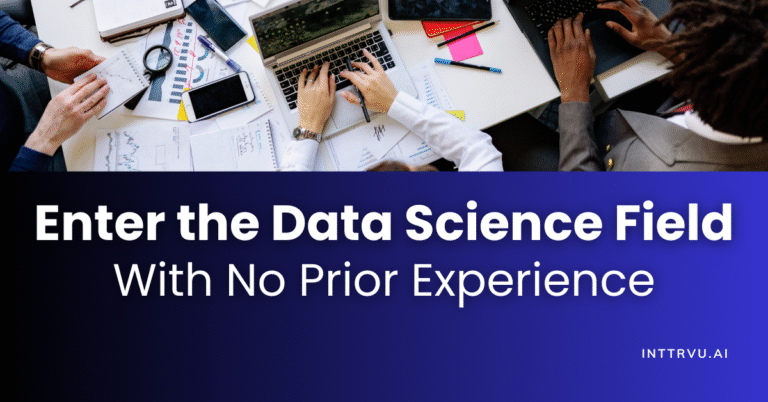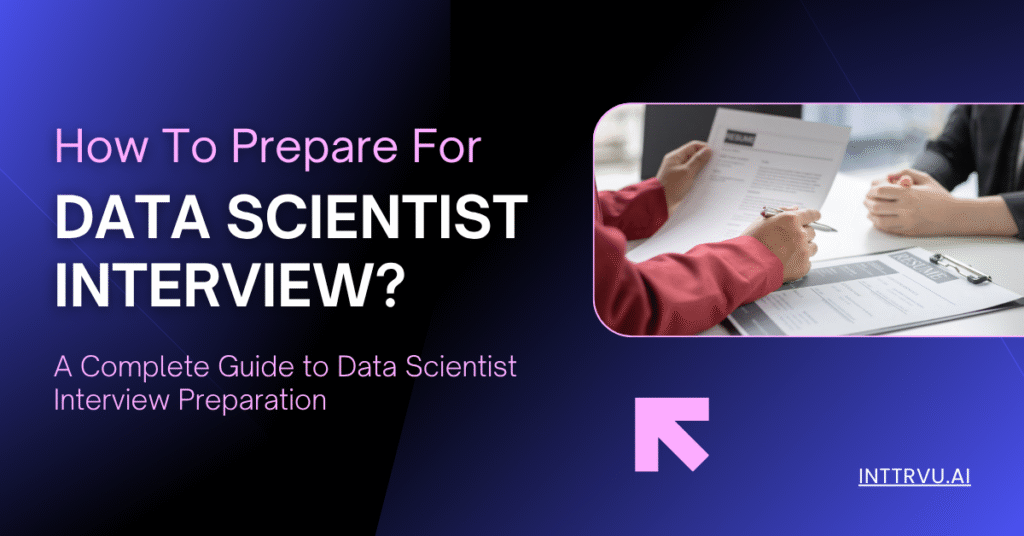How to Prepare for a Data Scientist Interview?
A Practical Guide to Crack Your Next Big Career Move
You’ve applied, you’ve built a portfolio, and now, you’ve been shortlisted for a data science interview. That’s no small achievement, and you should be proud. But now comes the real challenge: proving your skills, your thinking, and your potential under pressure.
At this point, you’re probably wondering:
- What type of interviews should I expect?
- How do I prepare technically? What should I revise?
- What will they ask about my past experience or projects?
- How do I confidently transition into a data role if I come from another background?
These are the exact questions we’ll answer in this guide.
Whether you’re a working professional moving into data science or a student preparing for your first role, this article will walk you through how to clear data science interviews, what to focus on, and how to stand out in a highly competitive job market.
Start With Background Research
Before diving into coding or statistics, start by learning about the company you’re interviewing with. This step is often underestimated, but it plays a major role in how well you connect with the interviewer.
Revisit the job description. What tools or responsibilities are highlighted? Align your answers and experiences to those points. Take time to understand the company’s core products and how data could add value to them, think in terms of personalization, optimization, or prediction.
If possible, look up your interviewer. Do they publish content? Are they active in data communities? This helps you anticipate the tone and focus of the interview and prepares you to have a more natural, thoughtful conversation.
Understand the Interview Format
Data science interviews aren’t one, size, fits, all. Most companies use a multi-stage process to assess both technical and behavioral fit.
Here’s a quick overview of what you can expect:
- Phone screen: Often with HR or a recruiter. You’ll be asked about your background, motivations, and availability. Be clear and concise.
- Technical round: Typically includes Python, SQL, statistics, and machine learning questions. This may be a live coding round.
- Behavioral round: Focuses on teamwork, communication, and problem-solving. Use real stories from your experience.
- Managerial or business round: Tests your ability to translate data into value. Expect scenarios, based questions, and a deeper dive into your past projects.
If you’re looking for structured support, you can explore interview preparation platforms that simulate real-world settings. These are especially helpful for professionals who haven’t interviewed in a while or are transitioning roles.
Strengthen Your Technical Core
Technical preparation is essential, but it needs to be focused. Instead of reviewing everything, concentrate on high-impact areas that show up frequently in interviews.
Python
Python remains the top language for data science roles. Make sure you’re comfortable with:
- Data manipulation using Pandas and NumPy
- Writing functions and solving numerical analysis problems using Python
- Cleaning and transforming datasets
Get a complete guide to basic interview questions on Python, including key concepts, coding examples, and tips to confidently crack Python Interviews.
SQL
SQL is often the first round of technical evaluation. Interviewers use it to gauge your data thinking.
Expect questions on:
- Joins and aggregations
- Window functions
- Subqueries and CTEs
- Writing optimized, readable queries
Practice problems that mimic real business scenarios, not just textbook queries. Check out this guide on SQL concepts.
Statistics and Probability
Focus on statistical concepts that directly apply to business problems. These include:
- Hypothesis testing
- Confidence intervals
- A/B testing
- Probability distributions
Many candidates know the theory but struggle to apply it in interview scenarios. That’s where mock interviews and expert feedback can make a big difference.
Machine Learning
Rather than memorizing algorithms, concentrate on understanding when and how to apply them. You should be able to discuss:
- Feature selection
- Overfitting and underfitting
- Regularization
- Model interpretability
If you’re new to ML interviews, start with this guide on machine learning interview questions.
Showcase Real-World Projects
Interviewers want to see how you apply theory to practice. That’s where your projects come in.
Pick 2–3 projects that demonstrate a mix of technical depth and business impact. Think churn prediction, customer segmentation, time series forecasting, or recommendation systems. Your focus should be on storytelling, what was the business problem, how did you approach it, and what did you deliver?
If you’ve never worked in a formal data role before, that’s okay. Guided mentorship programs and portfolio,building services can help you select and shape impactful projects that align with job expectations.
Don’t Skip the Behavioral Questions
Even the most technical interviews include behavioral rounds. These are used to assess how you think, communicate, and handle workplace challenges.
Be ready to answer:
- Tell me about a time you failed and what you learned
- Describe a conflict in a team and how you resolved it
- How do you prioritize tasks under tight deadlines?
Structure your answers using the STAR method (Situation, Task, Action, Result), and rehearse them through mock interviews for clarity and flow.
Optimize Your Resume and LinkedIn Profile
Your resume and LinkedIn profile are often reviewed before you even get a call. Treat them as your personal pitch decks.
Resume
Keep it focused, clean, and results driven. Here’s how to enhance it:
1. Resume Summary (Example)
Data-driven professional with 4+ years of experience in software development and a strong focus on analytics. Skilled in Python, SQL, and Machine Learning with hands-on experience in building predictive models and business dashboards. Transitioning into data science with a proven ability to apply statistical thinking to real-world problems.
2. Relevant Experience
Describe what you achieved, not just what you did. Use metrics.
For example, Improved model accuracy by 15% by implementing feature selection and hyperparameter tuning
3. Projects/Portfolio
Add a dedicated section for 2–3 end, to, end projects. Link to GitHub or your portfolio site when possible.
LinkedIn acts as a live version of your resume,often the first thing a recruiter checks.
1. Headline Example
Data Science Professional | Ex,Software Engineer | Python • SQL • Machine Learning | Building Data,Driven Solutions
2. About Section Example
I’m a data professional with a background in full-stack development and a passion for solving problems using data. I’ve worked on projects across customer analytics, forecasting, and automation, and I’m now focused on contributing to data-first teams that drive measurable business outcomes.
3. Featured Section
Include links to top projects, blogs, or certifications. Show, don’t just tell.
4. Keywords & Endorsements
Make sure your listed skills match what hiring managers are searching for, Python, SQL, Pandas, Scikit-learn, Tableau, etc.
Platforms like GenAiPrep are helpful here, they offer simulated interviews, structured feedback, and coaching to improve your delivery.
Summary Table: What to Focus On
| Area | What to Prepare | Support You Can Explore |
|---|---|---|
| Company Research | Products, job description, team background | Interview guides, prep templates |
| Technical Round | Python, SQL, statistics, ML | Practice platforms, mock tests |
| Project Portfolio | Real,world use cases with measurable impact | Mentorship, project reviews |
| Communication Skills | STAR answers, storytelling | Behavioral mock interviews |
| Resume & LinkedIn | Quantified results, updated projects | CV review tools, GenAiPrep |
Final Thoughts
Cracking a data scientist interview isn’t about knowing everything; it’s about knowing how to prepare strategically. A strong foundation in Python and SQL, a good grasp of statistics, business, savvy projects, and clear communication are the pillars of success.
If you’re serious about transitioning into data or levelling up your analytics career, consistent preparation and expert guidance go a long way. Tools like mock interviews, CV reviews, and career coaching, offered by platforms such as GenAiPrep , can help you bridge the gap between where you are and where you want to be.
And when you’re ready to take the next step, explore the Data Science Interview Preparation hub on INTTRVU.AI for curated resources, guides, and interview kits that match your goals.
Frequently Asked Questions
Ideally, 2–3 months of structured preparation works well, especially if you're shifting domains. Consistency matters more than cramming.
Underexplaining projects, lack of clarity in answers, and poor communication. Practice and feedback can help fix this.
Not at all. Strong skills, real,world projects, and a focused narrative often matter more than degrees.

Master Data Science While Working | Best Data Science Course
Master data science without quitting your job. Discover practical strategies, real-world projects, and expert tips to balance work and learning. Explore the best data science classes and find the right data science course to grow your career in data science.

Enter the Data Science Field with No Prior Experience
Thinking about a career switch? This blog explains how to transition into data science step by step. Explore a beginner-friendly data science course and a practical data science course syllabus that covers Python, SQL, machine learning, and portfolio-building to help you land your first role.



